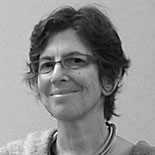

AIA, LEED APM
As Interviewed By:
Paul: How did you come to be the sustainable design director at HOK?
Mary Ann: As sustainable design took hold at HOK in the early 1990s, I emerged as a participant in its widespread implementation. My involvement reached a new level after a 2001 Leadership Convention at HOK, when sustainability was named one of three key priorities. I agreed to help champion our sustainable design efforts, and it has evolved into my current role—promoting the implementation of sustainable strategies in all of our work.
Mary Ann's Recommended Reading
Biomimicry by Janine BenyusDesign with Nature by Ian McHarg
Architecture without Architects by Bernard Rudofsky
HOK Guidebook to Sustainable Design
Paul: As an expert in the built environment and someone who has studied biomimicry, can you give us examples of innovative uses of biomimicry in your projects?
Mary Ann: We are working with the Biomimicry Guild to master plan the 2,400-acre Mugaon mountain village, which is part of the Lavasa Hill Station community under development in India. The Biomimicry Guild is helping us to uncover the many ways plants and animals have learned to survive and thrive in this unique habitat, which experiences a three-month monsoon season immediately followed by complete drought. We are looking to nature for solutions to help manage and store water. Another challenge is the instability of the soils and the steepness of the slopes. To contend with that, we are analyzing the root systems of vegetation to develop strategies that mimic their performance.
Paul: What is an example of biomimicry that has great potential for design?
Mary Ann: Integrating biomimicry within interior environments is about much more than specifying bio-inspired products. It's about identifying a functional need and looking for inspiration from solutions that have been developed over millennia in nature.
As an example, given the importance of natural light in interiors in terms of both energy efficiency and human health and productivity, we see great opportunities to understand how nature drives light penetration deep into spaces.
For example, by looking at an emperor penguin's beak structure, we can learn strategies to reflect UV light, and by analyzing a begonia leaf, we can learn about how to use clear surfaces to focus light.
Paul: Do you see biomimicry becoming a mainstream practice in architecture?
Mary Ann: As we introduce biomimicry to our clients, we're finding those who are most receptive to the concepts are the ones who are eager to pioneer a cutting-edge, showcase project. They're also more likely to have an overall appreciation for nature. One of the most revealing questions we can ask clients is how they spend their free time. If they like to fish, hunt or hike, they're much more likely to be open to biomimicry than if they spend their weekends watching TV or fixing cars.
We hope more people over time will recognize biomimicry's potential to create renewable, regenerative outcomes that support positive human and natural systems interactions.
Within the built environment, however, biomimicry is still in its infancy. There are only a very small number of building projects throughout the world that have truly integrated biomimicry at the macro scale. Once we have completed built projects that exemplify a biomimetic approach, the understanding and adoption of its principles will grow quickly.
Paul: Which recent HOK project do you consider to be a breakthrough in sustainable practice?
Mary Ann: The King Abdullah University of Science and Technology is the first LEED certified project in the Kingdom of Saudi Arabia, and at 6.5 million square feet, it's the largest LEED Platinum project in the world.
In the context of an extremely hot, humid climate, our designers were asked to create a low-energy, highly sustainable project. The team was challenged to create a contemporary work of architecture that resonates with the global scientific community while being firmly rooted in local Saudi culture. Finally, and most definitively, the team was asked to design an institution of the highest physical quality at a historically unprecedented speed from conception to completion in just three years.
Paul: What was one breakthrough advance that you integrated in the project?
Mary Ann: Two solar towers use the energy of the sun along with prevailing Red Sea winds to create a natural ventilation effect that provides a high level of comfort throughout the year for people using the network of walkways that serve the campus.
Paul: How will green design continue to evolve?
Mary Ann: We need to effectively address the environmental and climate crisis by leapfrogging the current incremental sustainable improvements to develop profession-transforming solutions. We also know that there is little time left to make these kinds of dramatic shifts, so we're seeking partners like the Biomimicry Guild to help us lead this change.
Paul: Tell us something about yourself that we don't know.
Mary Ann: Given my concern with keeping down my carbon footprint, I know that air travel is not terrific, but I love to plan and execute great trips with my family. I was a language major in college before becoming an architect, and I love to study languages.
Over the years I've studied French, Russian, Italian, picked up a very little Spanish (a future goal), and most recently Greek before a visit to that architectural mecca (which now gives me the opportunity to read fraternity signs!).




















